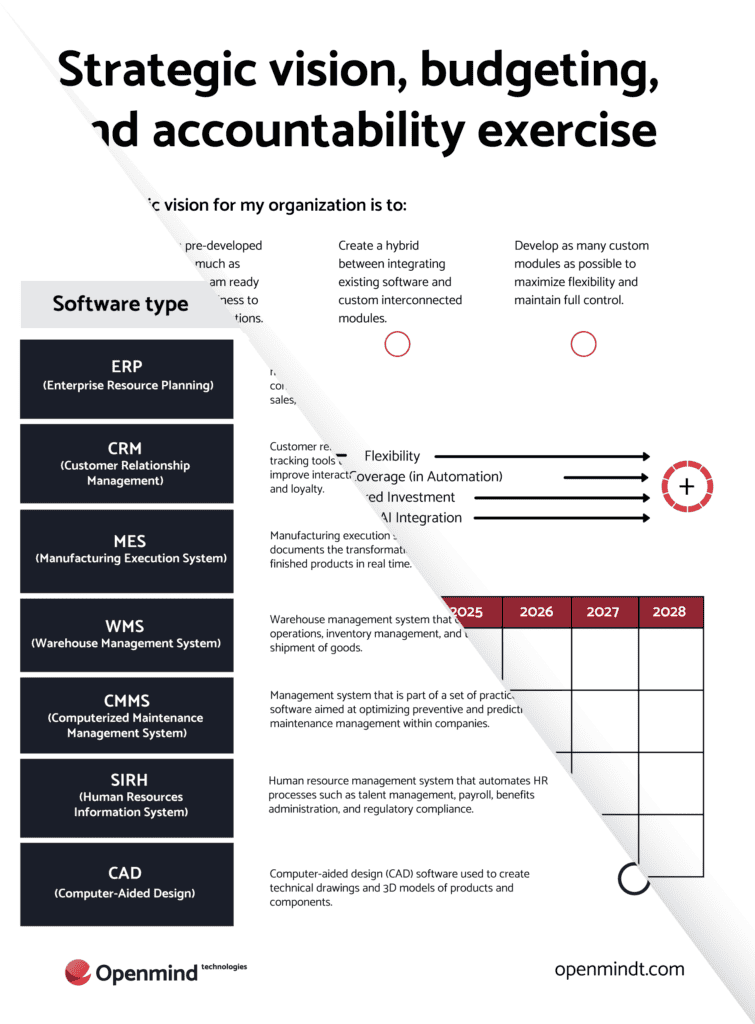Elevate your manufacturing strategy with key resources
Download our Technological Maturity Self-Assessment & Strategic Vision Exercise tools to assess your software ecosystem profile and to plan for future growth.

In today’s digital landscape, selecting the right software is essential for business efficiency. Whether you opt for custom or off-the-shelf software significantly impacts your company’s operations and growth. This article delves into the benefits and considerations of each option, guiding you to make the best choice for your business needs. Explore key factors like cost, flexibility, and scalability to determine the ideal software solution for your company.
It’s not uncommon for a company to use dozens or even hundreds of software programs, usually to automate tasks that were previously done manually.
There are two main types of enterprise software:
Both types of software have their advantages and disadvantages, and it can be difficult to decide which is best suited to your company’s needs.
On the one hand, off-the-shelf software is often more affordable than custom software, as it usually benefits from a broad user base, which helps to keep costs down for everyone involved.
However, custom software also has many advantages. It can be tailored exactly to your specific needs and requirements, so it’s more effective in achieving your business objectives, and it can adapt over time as your business evolves. This allows you to achieve maximum automation and profitability in your operations.
Factors to consider include the size and complexity of your company, the nature of your business and its unique requirements, as well as your budgetary constraints, time constraints and the availability of key resources/employees.
We generally recommend that companies take a good look at existing software solutions on the market for their needs. Customization is an option where costs can escalate rapidly. It’s important not to reinvent the wheel.
Here’s the first principle to bear in mind when making your decision: if you come across a piece of software that seems to do 80% of what you need, we strongly recommend that you explore this route first and foremost. Make sure you get good references from existing customers and, above all, get your requirements down on paper before making your final choice.
But in what contexts is software development preferable to large-scale commercial software?
Here are 6 situations where custom software will be more beneficial to your organization:


Download our Technological Maturity Self-Assessment & Strategic Vision Exercise tools to assess your software ecosystem profile and to plan for future growth.

Many companies in various industries utilize a “best-of-breed” approach, employing several highly specialized software packages to meet specific business needs. This practice is becoming increasingly common.
In such cases, the solution is to develop a data synchronization system among these software packages, often referred to as a “data bridge.” This approach allows you to harness the benefits of ultra-specialized solutions while seamlessly synchronizing data across all your software applications.
One of the key advantages of this approach is that, once the data synchronization system is in place, it becomes straightforward to create custom software layers on top of this foundation. This typically enables you to:
There are some “tablet” data bridge systems, such as Zapier and IFTTT. We recommend that you check out these alternatives before developing custom solutions to interconnect your systems. Again, there’s no value in reinventing the wheel. If the functionality you’re looking for is already available in systems like Zapier and IFTTT, it’s probably best to choose this option as a first step. Once you’ve reached the limits of these systems, customization will take care of itself.

If you’re a company trying to innovate continuously, chances are your ambitions are being held back by the functionality of the systems you’re using. There are two options:
The problems we generally see with the first option, asking your standard software supplier to customize it for you, are usually the following:
Large-scale software development differs significantly from custom system development, much like comparing a manufactured home contractor to a high-end custom home builder. Their methods and expertise are not interchangeable. Standard software suppliers find it challenging to maintain custom code branches while preserving a common software core—a cumbersome long-term management task. While standard software developers may initially use this approach to fund their operations, it can hinder growth and cause operational challenges with customers and production employees. Customizing standard software often means missing out on future updates, losing both the benefits of standard software and facing additional drawbacks.
We very often see this scenario, where the developer of the standard software indicates that the “famous” feature the customer wants will arrive soon. All too often, this feature ends up in an overcrowded workload, and the developer never manages to get to it. And when he does get there, very often the need has changed in the meantime, or the final functionality is not what the customer expected, since the developer has to develop for “all his customers”, not just one. How can this problem be avoided? Simply ask the software supplier these questions:
Many customers have experienced their standard software suppliers promising customizations when they “have time.” Unfortunately, over 95% of the time, these customizations never materialize. This is a common occurrence. Software suppliers prioritize requests beneficial to “everyone” rather than individual customers. Some customers even fund “for all” features, pushing custom requests to the supplier’s lowest priority. Consequently, your requests are often addressed last.
We very often see this scenario, where the developer of the standard software indicates that the “famous” feature the customer wants will arrive soon. All too often, this feature ends up in an overcrowded workload, and the developer never manages to get to it. And when he does get there, very often the need has changed in the meantime, or the final functionality is not what the customer expected, since the developer has to develop for “all his customers”, not just one. How can this problem be avoided? Simply ask the software supplier these questions:
If the software supplier doesn’t answer these four questions convincingly, there’s a very real risk that the functionality you want to see developed in the software will never actually be developed and delivered to your screen.
Interesting case. You’ve looked at all the well-known and lesser-known options on the market and none of them seem to meet your criteria, either in terms of functionality, service or quality?
What to do? Well, bespoke is unfortunately not the right idea here.
The first thing to consider is whether custom software development can :
To do this, you need to have an estimate of the development budget you’ll need to achieve your goals and, at the same time, bear in mind that a system maintenance budget will be required over time, i.e. around 10% of the annual development cost.
You then need to calculate whether the volume of operations you have, and the benefits per operation, are high enough to justify custom development.
In some cases, it may be possible to go ahead with custom development even if absolute profitability does not appear to be forthcoming. However, the benefit or advantage over the competition must be great enough to go ahead. Example: you develop a new platform to improve customer service. It won’t be directly profitable, but if no other competitor does it, it may become a great advantage over the competition.
If profitability or profit is high, then customization is a good option to explore.
Several success criteria must be written down and respected in order to make custom software development a success. Make sure you select the right partner.


Have you had custom software developed that gives you a big edge over the competition?
It’s possible to modernize your application, block by block, while limiting the impact on your operations. This makes it much less risky for your company to undertake custom development from a modernization angle, in order to maintain your competitive edge.

We often see companies deciding to drop their custom-developed software and migrate to standard solutions, facing a significant problem: a business “freeze” for 18 to 36 months. This transition can lead to operational chaos within the organization, much like what occurred with Phénix Payroll Systems and Services and the SAAQ in Quebec.
Several companies have come close to bankruptcy due to such migrations. For instance, in Canada, Target’s failure was attributed, in part, to their attempt to implement off-the-shelf software instead of importing their custom software from the USA. The complexity and poor fit of the system led to logistical chaos, empty shelves, and customer dissatisfaction.
When transitioning from custom to standard software, remember that it typically takes 12 to 18 months to regain full operational velocity, often resulting in reduced or negative operating profits during this period. Ensure you account for this in your calculations.

Uber, Facebook, Hubspot, etc. are all ideas for technological products that have been developed over time into a mature product.
Do you have an idea to develop? Tailor-made solutions are usually the best way to go.
However, it’s important to move forward intelligently. We strongly recommend good market research, feasibility studies and interactive mock-ups before developing a single line of code.
This will reduce your risks and increase your chances of success.
You shouldn’t choose custom software development by default. You should first check whether something already exists that meets your needs, so as not to reinvent the wheel. If such an option doesn’t exist, you’ll need to assess your needs, as well as your ability to assume the costs associated with having this kind of product come to life in your company.
However, in some cases, it can be an extremely effective way of reducing risk and staying ahead of the competition by providing unique solutions that meet your specific needs and requirements. Whether you have an idea for a new technology product, or want to modernize existing systems using new technologies, working with a trusted partner can help ensure success and maximum return on investment. So, if you’re considering taking the plunge and need a partner, make sure you do your research, consult experts and choose the right partner for your specific needs.
When deciding between custom or off-the-shelf software, it’s important to understand the specific advantages custom solutions can bring to your business. Our detailed guide on 7 Reasons Why a Company Needs Custom Programming provides valuable insights into how custom programming can enhance efficiency, scalability, and innovation tailored to your unique requirements.
Subscribe to receive our exclusive updates directly to your email.

Tell us more about your needs so that we can better route your project to our specific SWAT team.
1
During the brainstorming phase, we work with you to identify potential solutions to your business challenges to generate the technology response that aligns with your business objectives.
2
Through our requirements gathering process, we work closely with you to define and prioritize your needs, ensuring that our solutions are tailored to meet your specific requirements.
3
This phase marks the beginning of our partnership. We’ll finalize the project plan and establish clear communication channels to ensure a smooth and successful project execution.